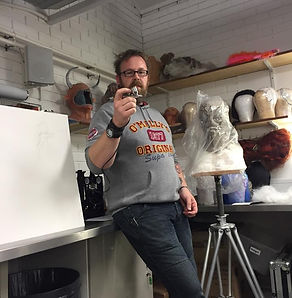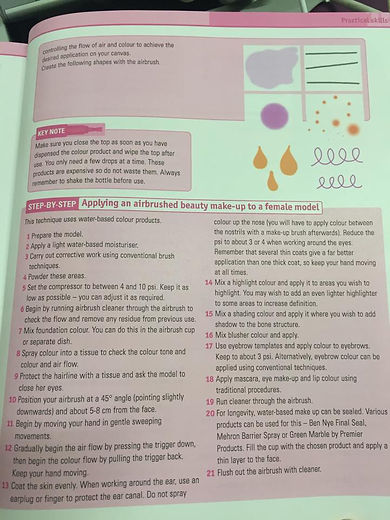Lucie Minty
Specialist Practice
Air Brushing
If using Illustrator paints to air brush onto your prosthetic piece, it would be better to colour the prosthetic right at the end because otherwise the paints would crack off. The IPA is what will make the paints crack off. A Blue bird pallect would work better if colouring a moving prosthetic pieces than an illustrator pallet because moves more.
Silicone paints can be diluted down and use on the silicone piece.
Don’t air brush silicone onto a prosthetic piece which has been applied to someones face. You would be better using grease paints to do this.
Demonstration:
-Crown cap: This protects the needle. If you want a fine pencil thin detail you will need to remove the crown. This is expose the needle so need to be very careful.
-Spray gun: This can be used for fibre glassing, spraying your mould, applying a thin layer of cap plastic onto the mould etc ( Is just a bigger air brush) Can be reffured to as a touch up guns and you can buy mini spray guns.
Advised to wrap the air brush wire around your hand so doesn't get in the way while airbrushing.
Two hands can mean more control.
Control practice techniques:
Curly cues- Technique used to practice with controlling the airbrush.
Grid of dots- Lets you practice starting and finishing without the paint splatting put of the needle( Keep the air on) and lets you practice your accuracy.
Make sure paint doesn’t get clogged by the needle as this will effect your work. If the air brush gets clogged take the crown off, pull the trigger back (which will pull the needle back into the air gun) and clear the end.
For a pencil thin technique, take the crown off and decrease the air pressure.
If use silicone paint through an air brush, it will never clean properly. So can only use silicone, tempu and IPA (This will only effect you if you want to paint a car or helmet. From a makeup artist point this doesn't effect anything.)
Creating different textures:
Splatter technique:
Use a pencil in-front of the air brush at an angle so the paint sprayed from the air brush hits off the pencil tip and lands on the paper.
Fur impressions:
Cheap fan paint brushes are good for a fur effect. Needs to have thick hard bristles. Place the fan brush on top of the paper then spray over the top of it.
Hard and soft masking:
From stencils you can create Hard and Soft masks.
Soft masking is from a distance.
Hard masking is from close.
Inline water trap: This makes releasing air easier.
Always release the trapped water/air after every use before you put the air brush away.
Air pressure:
20psi is a good pressure to set the air brush on. Do not set to high because can be really dangerous for the model.
Low air pressure for thin paints, higher pressure for thicker paint.











Conway, J. (2004). Make-Up Artistry: for Professional Qualifications. Oxford: Heinemann Educational.
Conway, J. (2004). Make-Up Artistry: for Professional Qualifications. Oxford: Heinemann Educational.
Conway, J. (2004). Make-Up Artistry: for Professional Qualifications. Oxford: Heinemann Educational.
This book shows various air brushing techniques. It demostrates different techniques to practice controlling the air brush which wayne demonstrated during the air bursh recap demonstartion.